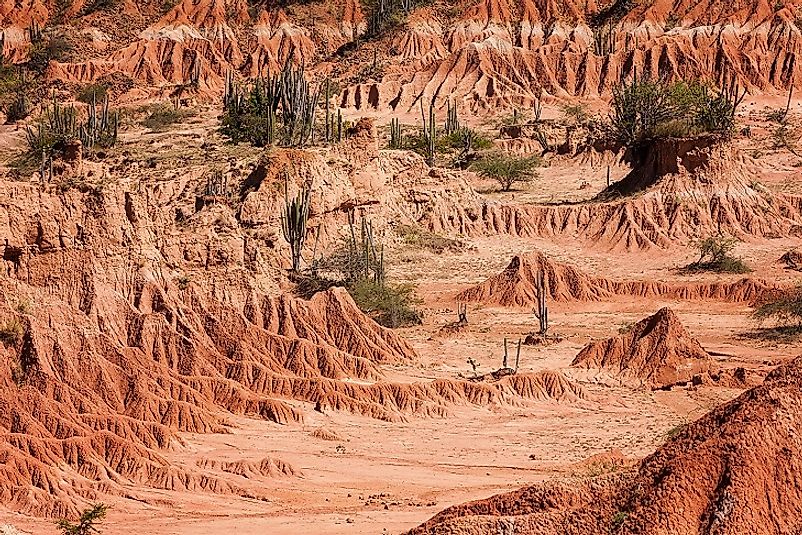The Tatacoa Desert Of Colombia

5. Description
The Tatacoa Desert, also known as the Valley of Sorrows, spans an area of 330 square kilometers in Colombia, being the second largest arid expanse in the country after the Guajira Peninsula. The region is located 38 kilometers from the city of Neiva, the capital of the Department of Huila. The Tatacoa Desert does not fit into the conventional definition of deserts as it lacks any form of sand deposits or sand dunes but is instead a heavily eroded rocky terrain scarred by dry canyons which hosted lush, green tropical forests during the Tertiary Period. Two distinct regions occur within the Tatacoa Desert, the ocher-colored Cuzco landscape, and the grey-colored Los Hoyos landscape.
4. Historical Role
The Tatacoa Desert served as the home of thousands of species of plants and animals in prehistoric times and this fact is evident from the discovery of a large number of prehistoric fossils at this site. The desert is believed to host the most diverse paleontological records of the continent dating back to the Miocene and Pleistocene period. Paleontologists from various institutes of Colombia, the U.S.A., and Japan have thus been attracted to this site to study the fossilized remains and evolutionary history of the lost species. One of the most important fossil specimens were discovered here in the La Tatacoa area which belonged to the early primates of the world, providing scientists a further insight into mechanisms of the evolutionary process. Besides plant and animal life, the Tatacoa Desert also presents evidence of cultural evolution of humans. Relics from prehistoric anthropological sites dating back to the Pleistocene and early Holocene have been discovered here. This has helped anthropologists study the development of Indian and other indigenous cultures in Columbia.
3. Modern Significance
Besides paleontologists, archaeologists and anthropologists, the Tatacoa Desert also attracts a large number of tourists who visit the site to explore its unique terrain, historical, geological and paleontological wonders. An astronomical observatory at the pollution free location allows detailed observations of astronomical objects through telescopic eyes. Many tourists camp at the desert or hike along its terrain to marvel at its geological wonders. An artificial swimming pool created in the desert landscape is also a major tourist attractant in the area.
2. Habitat and Biodiversity
The Tatacoa Desert region is subject to high temperatures and low humidity. The plants and animals inhabiting this region are thus well adapted to survive in the extreme conditions of the desert. The plants growing here have an extensive system of roots that spread over long distances both horizontally and vertically. Animal life here includes such reptiles as turtles, snakes, alligators, and lizards, several species of invertebrates like spiders and scorpions, such mammals as rodents and wildcats, and birds of prey like eagles and other birds.
1. Environmental Threats and Territorial Disputes
Since the Tatacoa Desert is uninhabitable and effectively not arable, the desert habitat is spared from human interventions. Thus, adverse effects of anthropogenic activities like high levels of air pollution, the decimation of wild species for human needs, and damage to the archaeological and paleontological treasures from encroaching human settlements, do not exist in this region. Future potential threats from a growing tourist burden can, however, be not ruled out. Emissions from tourist vehicles could impact that air quality of the region and waste generated by tourists might mar the pristine nature of the Tatacoa Desert.







